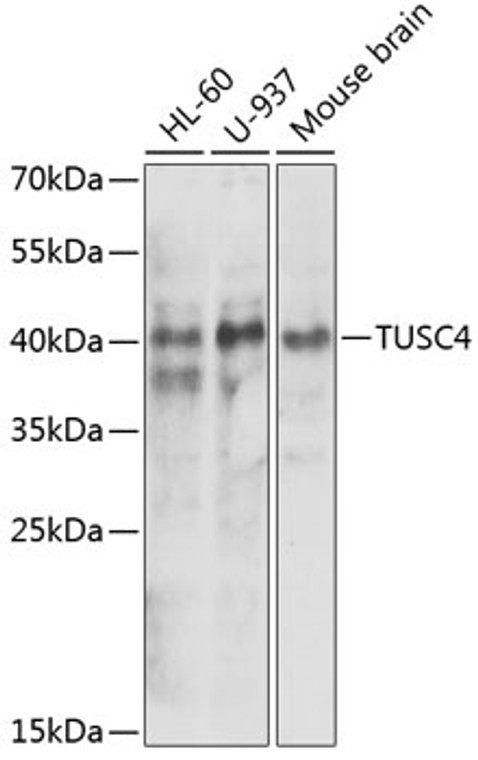| Host: |
Rabbit |
| Applications: |
WB/IF/ICC/ELISA |
| Reactivity: |
Human/Mouse/Rat |
| Note: |
STRICTLY FOR FURTHER SCIENTIFIC RESEARCH USE ONLY (RUO). MUST NOT TO BE USED IN DIAGNOSTIC OR THERAPEUTIC APPLICATIONS. |
| Clonality: |
Polyclonal |
| Conjugation: |
Unconjugated |
| Isotype: |
IgG |
| Formulation: |
PBS with 0.02% Sodium Azide, 50% Glycerol, pH 7.3. |
| Purification: |
Affinity purification |
| Concentration: |
Lot specific |
| Dilution Range: |
WB:1:500-1:2000IF/ICC:1:50-1:200ELISA:Recommended starting concentration is 1 Mu g/mL. Please optimize the concentration based on your specific assay requirements. |
| Storage Instruction: |
Store at-20°C for up to 1 year from the date of receipt, and avoid repeat freeze-thaw cycles. |
| Gene Symbol: |
NPRL2 |
| Gene ID: |
10641 |
| Uniprot ID: |
NPRL2_HUMAN |
| Immunogen Region: |
1-220 |
| Specificity: |
Recombinant fusion protein containing a sequence corresponding to amino acids 1-220 of human NPRL2 (NP_006536.3). |
| Immunogen Sequence: |
MGSGCRIECIFFSEFHPTLG PKITYQVPEDFISRELFDTV QVYIITKPELQNKLITVTAM EKKLIGCPVCIEHKKYSRNA LLFNLGFVCDAQAKTCALEP IVKKLAGYLTTLELESSFVS MEESKQKLVPIMTILLEELN ASGRCTLPIDESNTIHLKVI EQRPDPPVAQEYDVPVFTKD KEDFFNSQWDLTTQQILPYI DGFRHIQKISAEADVELNLV |
| Tissue Specificity | Most abundant in skeletal muscle, followed by brain, liver and pancreas, with lower amounts in lung, kidney, placenta and heart. Expressed in the frontal lobe cortex as well as in the temporal, parietal, and occipital lobes. Expressed in most lung cancer cell lines tested. |
| Post Translational Modifications | In the presence of abundant amino acids, ubiquitinated at Lys-158 and Lys-357 via 'Lys-6'-linked ubiquitination by the WDR24 component of the GATOR2 complex, thereby inhibiting the GATOR1 complex and promoting mTORC1 activation. Asymmetric dimethylation at Arg-78 by PRMT1 inhibits the GTPase activator activity of the GATOR1 complex and consequently inducing timely mTORC1 activation under methionine-sufficient conditions. |
| Function | Catalytic component of the GATOR1 complex, a multiprotein complex that functions as an inhibitor of the amino acid-sensing branch of the mTORC1 pathway. In response to amino acid depletion, the GATOR1 complex has GTPase activating protein (GAP) activity and strongly increases GTP hydrolysis by RagA/RRAGA (or RagB/RRAGB) within heterodimeric Rag complexes, thereby turning them into their inactive GDP-bound form, releasing mTORC1 from lysosomal surface and inhibiting mTORC1 signaling. In the presence of abundant amino acids, the GATOR1 complex is ubiquitinated and inhibited by GATOR2. Within the GATOR1 complex, NPRL2 constitutes the catalytic subunit that mediates the GTPase activator activity and under methionine-sufficient conditions, the GTPase activator activity is inhibited by PRMT1 through methylation and consequently inducing timely mTORC1 activation. Suppresses Src-dependent tyrosine phosphorylation and activation of PDPK1 and its downstream signaling. Down-regulates PDPK1 kinase activity by interfering with tyrosine phosphorylation at 'Tyr-9', 'Tyr-373' and 'Tyr-376' residues. May act as a tumor suppressor. Suppresses cell growth and enhances sensitivity to various anticancer drugs. |
| Protein Name | Gator1 Complex Protein Nprl2Gene 21 ProteinG21 ProteinNitrogen Permease Regulator 2-Like ProteinNpr2-Like ProteinTumor Suppressor Candidate 4 |
| Database Links | Reactome: R-HSA-9639288 |
| Cellular Localisation | Lysosome MembraneLocalization To Lysosomes Is Mediated By The Kicstor Complex And Is Amino Acid-Independent |
| Alternative Antibody Names | Anti-Gator1 Complex Protein Nprl2 antibodyAnti-Gene 21 Protein antibodyAnti-G21 Protein antibodyAnti-Nitrogen Permease Regulator 2-Like Protein antibodyAnti-Npr2-Like Protein antibodyAnti-Tumor Suppressor Candidate 4 antibodyAnti-NPRL2 antibodyAnti-TUSC4 antibody |
Information sourced from Uniprot.org
12 months for antibodies. 6 months for ELISA Kits. Please see website T&Cs for further guidance








